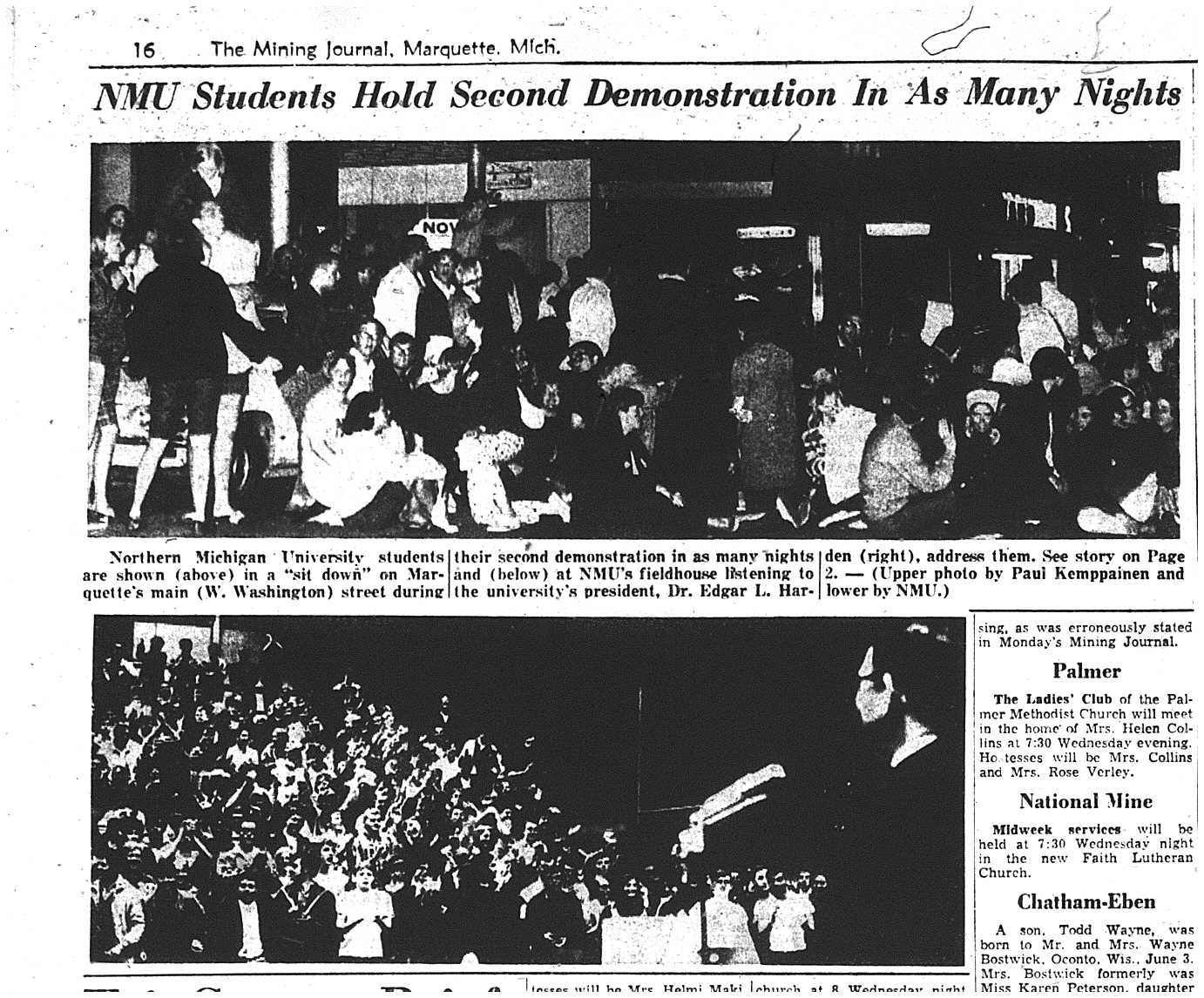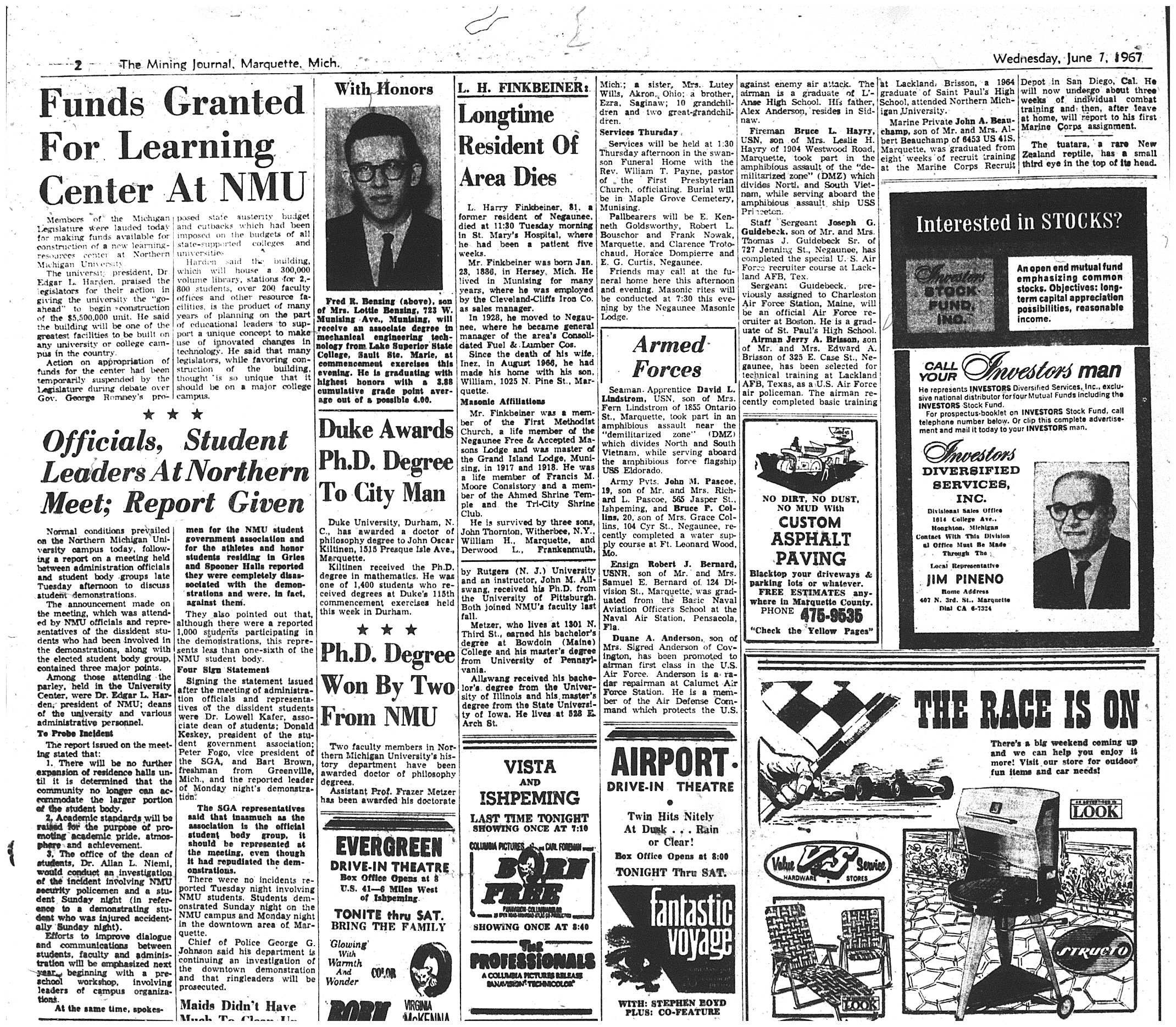Spring Campus Issues Protests
c. 1967
After this spurt of protesting in 1965, Northern’s campus was fairly quiet until the spring of 1967. Pressures mounted as the rising enrollment caused residential problems. Dorm rooms designed to hold two people now typically housed three, and most students were still not allowed to live off campus even if they were juniors or over twenty-one. Suddenly, protests sprang up on the campus again about a myriad of campus issues. Students “protested the food and three being assigned to the room, and called for off-campus housing.”
According to an e-mail the Archives received from Bart Brown, a student leader of the protests, students first gathered at the President’s house and asked him to speak with them. When the President did not respond, the students decided to take their demonstration to the streets of Marquette.
The Mining Journal reported on 6 June 1967 that “Around 1000 Northern Michigan University students staged their second demonstration in as many nights.” They walked into the “business district” of Marquette and sat down on the block between 3rd and Front Street. Police escorted the students to prevent any violence, though they noted that the students were “orderly…There was no profane language used, although there was a lot of singing, chanting, and shouting.”
Although the police praised the lack of real disruption, they still stated that, “ ‘[W]e cannot tolerate this sort of practice, which is contrary to city ordinance. Therefore, an investigation is being made, and we expect to make arrests. The ringleaders will be prosecuted.’ Among other charges, the police chief noted, the ringleaders can be charged with unlawful assembly, obstructing traffic and being disorderly.”
Dr. Allan Niemi, Dean of Students, came and asked the students to cease protesting, come back to campus, and hear Dr. Harden speak. Bart Brown explained in an e-mail to the Archives what happened next:
The gym was opened for this purpose, by that time very late at night, and there an agreement was reached to discuss issues raised in subsequent meetings between students and administrators. I was detained on the way back to campus from downtown by NMU security, including Curt Marker, who may have gone on to play for the Dallas Cowboys (you'd have to check that), but was released when students, assembled by then in the gym, wouldn't let President Harden speak until I was released.
Harden told the Mining Journal that he “‘thoroughly enjoyed visiting’ with the students and that he ‘respected their rights.’” He told the students, “I want you to be responsible students, however, and I hope you refrain from any actions which would lead to restrictions by the legislators, which has been done in some states.”
On 7 June 1967, the Mining Journal reported that, “normal conditions prevailed on the Northern Michigan University campus today, following a report on a meeting held between administration officials and student body groups late Tuesday afternoon to discuss student demonstrations.” Dr. Harden, university deans, and other administration members met with student leaders to discuss the issues which had caused the protest. According to the Mining Journal, the meeting resulted in three agreements:
- There will be no further expansion of residence halls until it is determined that the community no longer can accommodate the larger proportion of the student body.
- 2. Academic standards will be raised for the purpose of promoting academic pride, atmosphere, and achievement.
- 3. The office of the Dean of Students, Dr. Allan L. Niemi, would conduct an investigation of the incident involving NMU security policemen and a student Sunday night This was in reference to a demonstrating student who was injured accidentally that Sunday night.
Signing the statement issued after the meeting of administration officials and representatives of dissident students were Dr. Lowell Kafer, associate dean of students; Donald Keskey, president of the student government association; Peter Fogo, vice president of the SGA, and Bart Brown, freshman from Greenville, Mich., and the reported leader of Monday night’s demonstration”. The SGA told the Mining Journal that they were not associated with the protests and disagreed with them, but as leaders of the student body they were required to be there.
Bart Brown’s e-mail to the Archives gives an inside look at what happened at the meeting from the perspective of the protesters:
"I, together with a student named David Bay, subsequently met with administrators as agreed. We discussed a range of issues, from the growing student anti-war sentiment that clashed with that of an administration more amenable to the ' 65 YAF pro-war demonstration (their hundreds to our thousands; the YAF didn't go up against us) to the lack of extracurricular activities on and off campus. In the end we agreed only on some practical areas of concern, such as campus security working unarmed, we only succeeded clearly in ensuring a safe environment for protests…"
The Marquette community opposed the protests and worried that they would get worse. One woman wrote to the Mining Journal, “In my opinion, a demonstration that is impromptu cannot in any aspect be orderly. Although nothing serious happened this time, mass hysteria is also impromptu, and people get killed during such times.”
Bart Brown's email to the Archives further explains that:
"President Harden's master plan for NMU, to expand the campus into North Marquette and fill new dorms with 'Right to Try' students, was quantitative. Student interests were different: we wanted our money's worth, from the quality of our accommodation and food to the value of our degrees, and to be good neighbors, including and especially with working poor North Marquette families (whom we stood up for before Columbia students stood up for their poor neighbors in University-adjacent Morningside Heights for the same reason). There were other issues to be sure, our student body would never be known for war mongering again after Spring 67, as just one example of the changes begun then. The agreement between the Harden administration and dissident students, in its stoppage of campus expansion and commitment to raising academic standards, was a complete defeat for President Harden. At the same time, we realized that our most important accomplishment was the assumption of a place at the adult table, the bargaining table, in the governance of the university, and we understood the student rights President Harden was compelled to explicitly acknowledge that spring night in 1967, would have to be exercised and defended by succeeding generations of Northern students, and we trust they will join us in this understanding..."
As this school year ended, another momentous event occurred. Dr. Harden retired from his post as Northern Michigan University President. Bart Brown asserted that he believes the events of the spring of 1967 influenced future student protests at Northern:
"Edgar Harden leaving NMU's presidency for the presidency of the Story Oldsmobile dealership was clearly related to the events of 1967, and that those roles were interchangeable in Harden's view pretty much tells his story. Most observers saw this change of positions as a career train wreck (although Harden's later brief appointment as interim president at MSU, with which he had been previously associated, salvaged his resume to some degree). We felt that Harden's world view personified what our generation was up against and his departure from NMU was viewed as a victory of the incoming new over the outgoing older generation, which sentiment and fact was not lost on successor presidents….In Spring ' 67 we were in transition, our numbers were relatively very large and there was more spontaneity and trust/less planning and caution than either before or after that time, and while the range of issues make this transition relatively more difficult to describe and categorize, which difficulty was seized upon by the Harden administration to try to minimize this event, it was nonetheless an indispensable stage of the period reviewed…the Spring ' 67 demonstration at NMU, that was uniquely carried out by students alone, changed everything at NMU."

